
|   |

|   |
'Dramatic Tales' receives houseful standing ovation at the NMACC - Sumana Sachidananda e-mail: sumanas29@gmail.com Photos: Inni Singh, Krishna Chakravorty, Ashwini Kumar March 24, 2025 Renowned Kuchipudi Guru and choreographer Vanashree Rao created Rasa United, a multi- style dance team, a decade ago, to present dramatic tales from the Indian epics in a grand avatar. The team has performed in Khajuraho, Egypt India festival, Purana Quila Delhi, SNA choreography festival Manipur, Konark festival to name a few and received rave reviews from all. 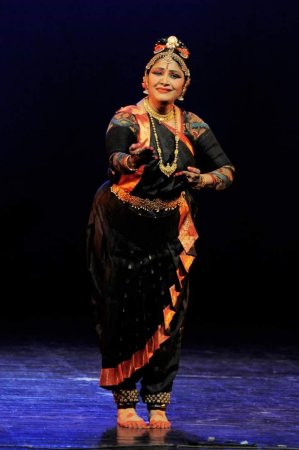 Vanashree Rao 'Dramatic Tales' by Rasa United was presented at the NMACC, Mumbai, on the 2nd of March. Right from the word go until the curtain call, this presentation exuded grandeur, colour, drama and finesse. Dancers of different Gharanas/ Banis find it difficult to perform together, citing stark differences in style and form. But here was a production with 3 different forms - Kuchipudi, Bharatanatyam and Chhau, that came together seamlessly. This show had the rasikas on the edge of their seats throughout, for which one must credit the creative genius of Guru Vanashree Rao. As a veteran Kuchipudi dancer who has mentored and nurtured several award-winning youngsters, she has dared to dream big and think out of the box. A polymath, her expertise ranges from music composition to Kalamkari textile design. All her various talents come in handy when she has to conceive a multi-lingual, multi-style, multi-text, multi-artiste production such as 'Dramatic Tales'. The NMACC is a prestigious theatre for the classical arts. To achieve a houseful standing ovation at the large Studio Theatre that commands premium tickets, is no mean feat. But this team deserved it as it has cracked the code of "how to entertain a discerning audience". 'Dramatic Tales' was presented in three parts - Tryambakam, Jagadoddhaarana and Abhimanyu Vadh. 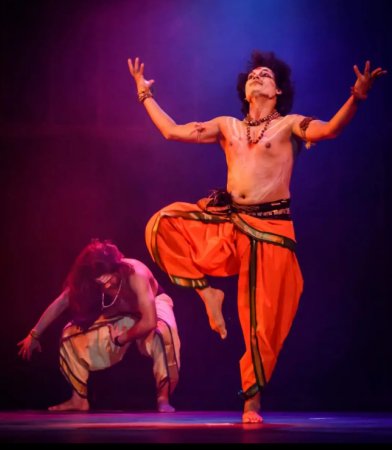 Aghoris in Tryambakam 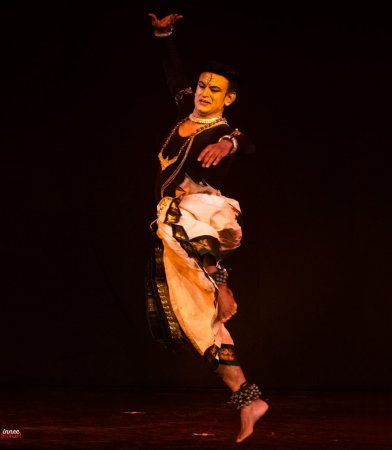 Sridhar Vasudevan as Shiva "Tryambakam" began with the exploration of the mysterious world of the Aghoris - the fearless, unconventional, Tantrik Shiv Bhakts. Opening with the strains of the Damaru, the music transported us to the surreal world of the mystics even before the dancers took centre stage. The Chhau dancers Kuleshwar Thakur, Deepak Kandhari and Mahesh Rautela performed various martial arts and yoga inspired movements, depicting the ritualistic processes of the Aghoris. They looked like Yogis and displayed fantastic agility, that is so essential to the form of Chhau. Sridhar Vasudevan's dynamic presence added a vibrant flavour to this piece. He was the dominant link throughout Tryambakam as the three-eyed Lord himself. He has a unique ang, emotive eyes and strong stage presence overall. He is one of a kind, ductile and malleable, making his mark in every sphere of the classical arts. 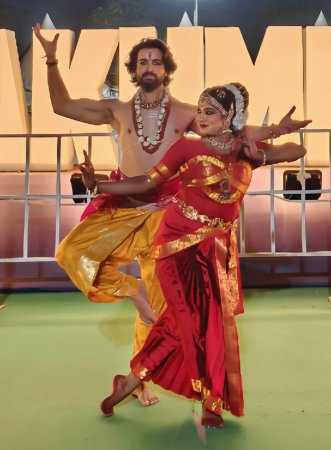 Prashant Kalia and Vishnupriya Marar in Ardhanareeshwara Following this was "Ardhanareeshwara", a Shiva-Parvati duet performed by Prashant Kalia and Vishnupriya Marar. Prashant's lethal presence on stage can be attributed to his lithe, supple body language and chiselled profile. Vishnupriya is a technically sound dancer, who is the embodiment of "Bhaava-Raaga-Taala" in dance. Vishnupriya's Bharatanatyam and Prashant's Chhau complimented each other perfectly, like Yin-Yang. As Prashant leapt and sprung across the stage as Shiva, Vishnupriya performed energetic jatis as Parvati. Their sizzling chemistry was the icing on the cake! The third piece on Lord Shiva was gripping and action-packed. It was the story of Kirata- Arjuna, an episode from the Vana Parva of the Mahabharata, when Arjuna encounters Lord Shiva in the forest. The story begins during the Pandavas' exile in the forest. Arjuna, the indomitable archer, undertakes severe penance to obtain divine weapons from Lord Shiva. As Arjuna's devotion reaches its peak, Lord Shiva decides to test his worthy devotee. When a demon named Muka, in the form of a wild boar, charges toward Arjuna, Shiva appears in the form of a tribal hunter / Kirata, accompanied by his consort Parvati (disguised as a tribal woman) and a group of attendants (Ganas). Arjuna and the Kirata aim at the boar simultaneously and shoot it down. They argue over who shot it first, and a battle ensues. They fight for a long time, and Arjuna is shocked that he cannot conquer the Kirata. As wisdom finally dawns on him, he recognises that his opponent is none other than Mahadev and surrenders. Lord Shiva bestows upon Arjuna the most powerful Pashupataastra, as a reward for his bravery and bhakti. Arjun Deb Malik excelled as the valiant Arjuna, and Vasudevan was authentic as Kirata. Their intense battle, performed in Chhau and Bharatanatyam respectively, was thrilling to watch. 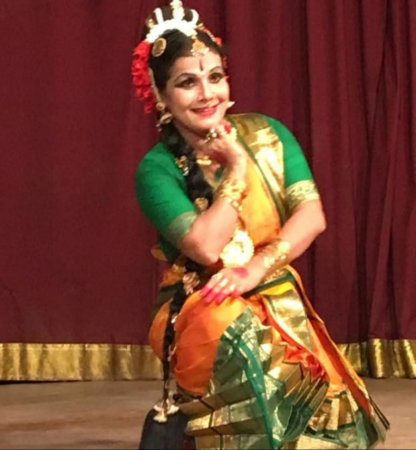 Boby Chakraborty 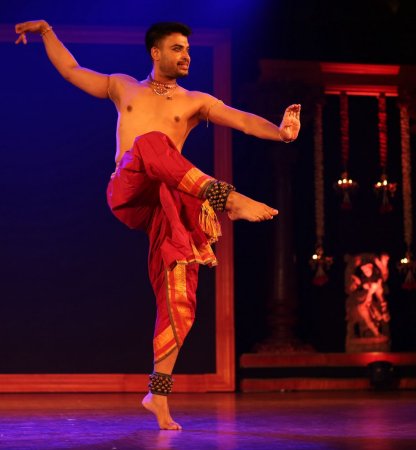 Washim Raja After Tryambakam, Guru Vanashree Rao descended on the stage as the Sutradhaar for "Jagadoddhaarana". The music for this piece was stirring. I was lost in the high notes of vocalist Venkatesh, who truly reached out to Krishna Paramatma from his core. Washim Raja, the emerging star of Kuchipudi, played the role of little, mischievous Krishna while Boby Chakraborty essayed Yashoda. The nuances of this mother - son equation were brought alive by the dancers beautifully. Yashoda punishes Krishna lovingly for his mischief, only to realise he is the Supreme one himself. Washim was a delight to watch, and I was asked several times by appreciative rasikas around me - "What's his name, he is so good!" Vanashree Rao cleverly incorporated an episode of Krishna, the master strategist from the Mahabharata, where he asks Dhritarashtra for 5 villages on behalf of the Pandavas, as a peaceful settlement to avoid a bloody war. The arrogant Duryodhana rejects this proposal and tries to capture Krishna. Krishna then emerges in his Viraat Swaroop (all-encompassing form) to humble Duryodhana. The verses were taken from Sanskrit scholar Srinivasachariar's Mahabharata. Washim, effortlessly slipped into the role of the conceited Duryodhana, right after portraying little Krishna. This is the hallmark of Kuchipudi's Eka Patra Abhinaya, which demands the ability to switch to diametrically opposite characters in a jiffy. Abhinaya is definitely Washim's forte as he is convincing in every role he assumes. Vanashree Rao as Krishna in his Virat Swaroop was magnificent. Her commanding presence lends itself to larger-than-life characters. Performances on Jagadoddhaarana are usually hackneyed, hence it was refreshing to see a distinct version of it with so many layers and subtexts. The overarching Bhakti Bhaava was palpable in this piece, especially during the lines "Anoraneeyana Mahato Maheeyana". Vanashree Rao illustrated how Krishna pervades every atom of the universe, and is unfathomable. This presentation was truly sublime. 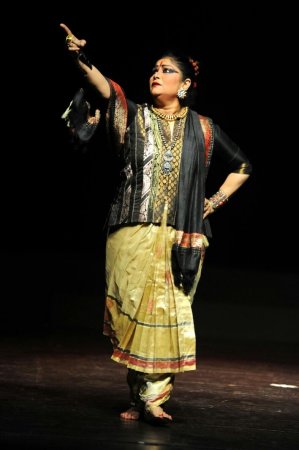 Vanashree Rao as Dronacharya The last piece was a fascinating and moving depiction of "Abhimanyu Vadh". Many consider Abhimanyu as the ultimate "Veera Purusha", who suffered an untimely death at the hands of the unethical Kauravas. This piece commenced with Vanashree Rao in the role of Dronacharya, lamenting the futility of war in the aftermath of Abhimanyu's killing. The Kurukshetra war was fought between cousins, but crores of people had to sacrifice their lives. This was a Dharma Yuddh, that had to be fought for the sake of righteousness. In a flashback scene, we saw Arjuna and his pregnant wife Subhadra enjoy each other's company in moments of tender love. Arjuna, the skilled warrior, explained to his wife the nuances of the labyrinth like Chakravyuh formation. This was the most formidable strategy to ensnare the enemy. As fate would have it, Subhadra fell asleep before she could hear the details of how to exit this formation. What transpired at the Kurukshetra war was the tragic killing of her son Abhimanyu by the Kaurava camp. Abhimanyu managed to break through the Chakravyuh, but couldn't figure his way out and succumbed at the hands of the deceitful Jayadrath. An enraged Arjuna vowed to avenge the death of his lionhearted son, and this became a turning point in the Mahabharata. Prashant Kalia did complete justice to the role of Abhimanyu, especially when he portrayed the courageous hero refusing to give up despite being wounded seriously. The acrobatic movements were performed by him flawlessly. Chhau doesn't have the dramatic facial expressions of the classical dance forms such as Kuchipudi and Bharatanatyam, but he was able to touch the hearts of the rasikas with his moving depiction of Abhimanyu. Kuleshwar Thakur, an established Chhau teacher, excelled in the role of the mighty archer Arjuna. The poignant closing scene when Arjuna affectionately embraces the corpse of Abhimanyu, and takes an oath of revenge, gave us goosebumps. What a rousing finale to 'Dramatic Tales'! 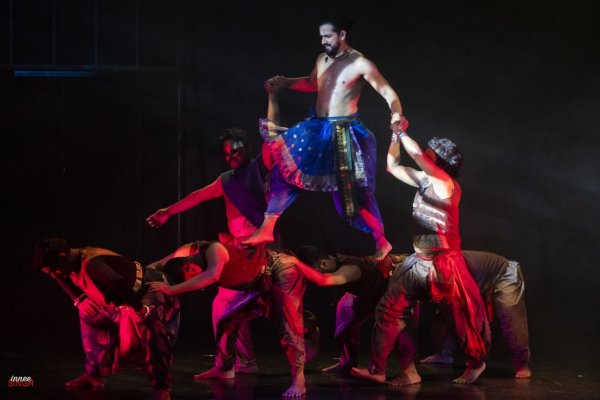 Abhimanyu Vadh There were countless moments during the show that took one's breath away. The music, the choreography, the costumes, the lyrics, and of course the actual dancing were all sensational. The mother of languages - Sanskrit is Vanashree Rao's favourite as she finds it profound and potent. She has researched several texts to carefully select impactful verses / lines for this production. One can say that she has painstakingly given birth to this enthralling child, that is prodigious in every sense. Our traditional artforms ought to be presented in such a manner with powerful storytelling, to attract audiences. This is how one innovates within the boundaries of the ancient art forms. This team deserves all the accolades and will hopefully get to showcase 'Dramatic Tales' at venues all over the globe!  Sumana Sachidananda is a Kathak dancer based in Mumbai. She is an MBA from ISB Hyderabad and has also trained in Carnatic music. She holds a Senior Diploma in Kathak from Bharatiya Vidya Bhavan and is a DD graded artist. |